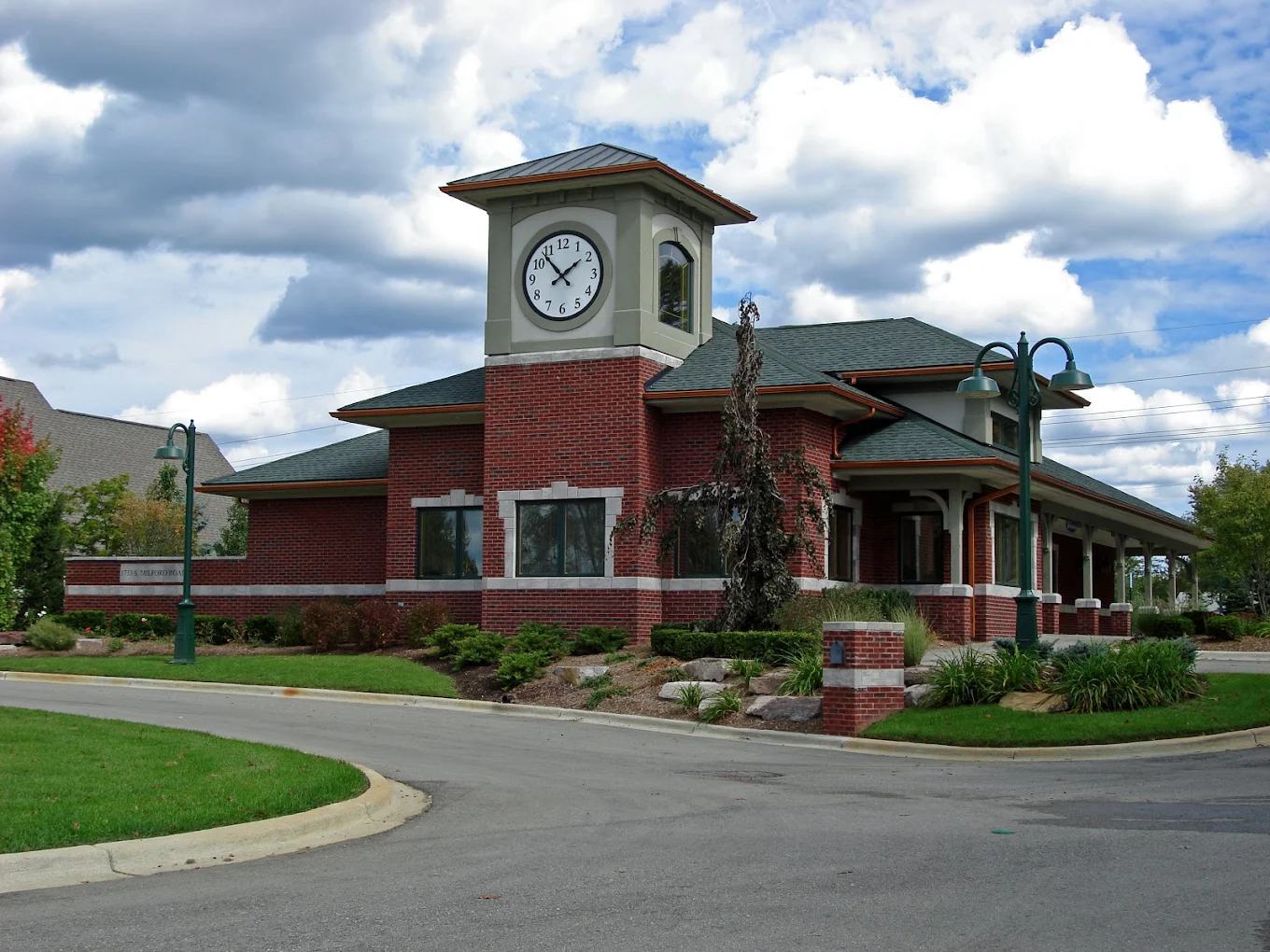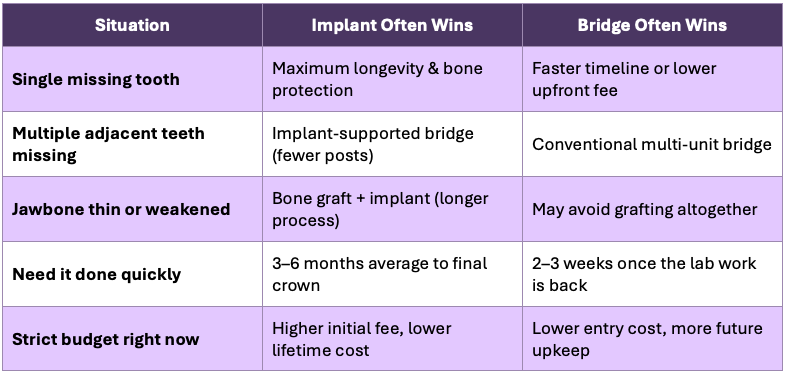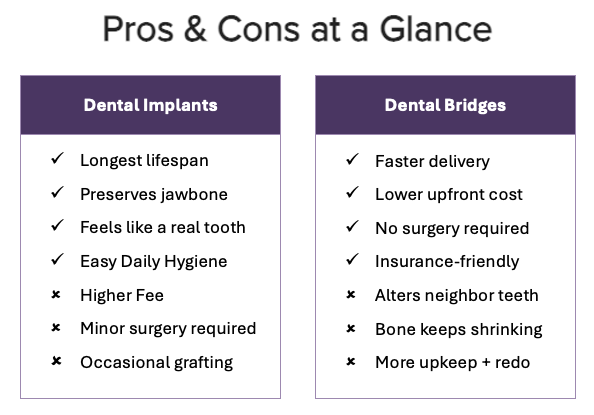
Expert dental tips, news, and smile advice

Expert dental tips, news, and smile advice
Losing a tooth is more than cosmetic—it alters the way you chew, speak, and even the shape of your face. Yet choosing dental implants vs bridges can feel like learning a new language. Below, we translate that jargon into clear, patient-centered guidance so you can decide with confidence and move forward without regret.


Direct answer? A single dental implant can last 25 years or longer, while a traditional bridge averages 10–15 years before replacement, making implants the more durable investment for most healthy adults.

1. Healing—What the First Few Months Feel Like
2. Everyday Care—What Your Toothbrush Will Notice
3. Long-Term Cost—The Math Behind the Choice
An implant asks for the bigger check today but rarely needs a sequel; many last 25 years or more. A bridge feels friendlier to the wallet upfront, yet national data show most require a full replacement roughly every 10–12 years. Add those cycles together and implants often win the lifetime-value contest.


Within the first 12 months after a tooth is removed, the jaw can lose up to 25 percent of its width because the bone no longer gets the micro-pressure signals that roots normally send. A dental implant–supported crown steps in as a new root, fusing to the bone and keeping those bone-building cells active; a bridge restores chewing surface but sits above the ridge, so the bone beneath keeps thinning—sometimes enough to change cheek contours or complicate future implant placement.
If you’re in your 30s or 40s, preserving bone now may spare you a graft later. During a comprehensive exam we capture a 3-D scan, measure ridge dimensions to the millimeter, and walk you through bone-saving versus bone-neutral options so you can decide with clear facts, not guesswork.

Is my gum health solid?
Active periodontal infection will sabotage any bridge or implant. We typically start with a deep cleaning or scaling & root planing to calm inflamed tissues so the foundation is healthy before we rebuild the tooth.
How strong are the neighboring teeth?
A bridge turns those teeth into load-bearing pillars. If they’re already crowned or filled, adding support may actually reinforce them; if they’re pristine, many patients choose an implant instead to keep untouched enamel untouched.
Am I okay with surgery?
Placing an implant post usually takes under an hour, and with our calming sedation dentistry, most people feel like they’ve had a long nap—but it is still minor surgery with a few days of routine healing.

At Fortson Dentistry in Highland, we start with a comprehensive exam and a 3-D CBCT scan. If the bone looks thin, we’ll map out graft timing or discuss whether a bridge will meet your short- and long-term goals. For many adults, we also explore implant-supported bridges—two implants replacing three or four teeth—which marries cost control with bone preservation.
We’re honest about timelines, too: a bridge can be wedding-photo-ready fast, while an implant rewards patience with decades of stability. Which value matters more to you? There’s no wrong answer—just the right answer for your lifestyle.



1. Can a bridge be converted to an implant later?
Yes. We often remove an aging bridge, place an implant (or two) in the same region, and craft single crowns. The key is jawbone volume. At our practice we’ll run a fresh scan to ensure enough height remains or plan grafting first.
2. Does insurance favor one option?
Most policies cover part of a bridge every 5–7 years but view implants as “elective.” However, many plans now allot a flat annual sum that you can apply to either. We provide a pre-treatment estimate so you see the numbers before deciding.
3. I’m a smoker—do implants still work?
Nicotine constricts blood vessels, delaying healing. Success rates dip about 10–15 percentage points among heavy smokers. We coach patients on temporary cessation (even nicotine patches) in the two weeks surrounding surgery to boost success.
4. What does an implant feel like in the mouth?
After the crown is seated, most people forget which tooth was restored. Because it’s anchored in bone, you’ll still sense pressure and temperature changes naturally, unlike a denture that presses on gum tissue.
5. Will my speech change?
Patients replacing front teeth often dread a lisp. An implant crown mimics natural contours, so speech rebounds quickly. A bridge can too, but if the pontic (false tooth) is bulky, we may adjust it until “s-” and “f-” sounds are crisp again.

Both options can return confidence and chewing power. Dental implants shine for longevity and bone health, while bridges excel when speed or immediate affordability tops your list. The smartest first step is a personalized evaluation—because the best dentistry is never one-size-fits-all.
Ready to talk through your choices?
Book online or call 248-887-3300 and ask for a no-pressure tooth-replacement consult. We’ll walk you through the scan results, share real cost comparisons, and let you decide on your timeline.
Discover the best solution for your smile at Fortson Dentistry. Schedule your appointment now and let our expert team guide you to a confident, healthy smile.

Looking for a trusted dentist near you? Fortson Dentistry is proud to serve patients in Milford, Highland, South Lyon, Hartland, White Lake, and surrounding areas.
Address: 1733 S. Milford Rd, Highland, MI 48357
Office Hours
Monday – Wednesday: 8:00 AM – 5:00 PM
Thursday: 8:00 AM – 3:00 PM
Friday - Sunday: Closed